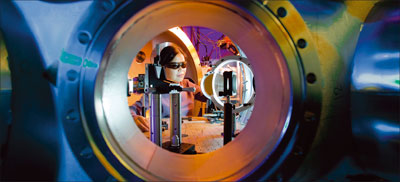
Image credit: LLNL.
The latest record for antiparticle density created in the laboratory has not come from an accelerator facility but from the Lawrence Livermore National Laboratory’s Jupiter laser facility. Hui Chen and colleagues blasted picosecond laser pulses carrying 1020 Wcm–2 from the Titan laser onto gold targets some 1 mm thick. Part of each laser pulse created a plasma and part drove the plasma’s electrons into the gold. The gold nuclei then slowed down the electrons, producing photons that converted into electron–positron pairs. The result was an estimated 1016 positrons/cubic centimetre.
In addition to being intrinsically interesting this work could aid better understanding of astrophysical phenomena such as gamma-ray bursts. It could also lead to new ways to produce positron sources, which at present are limited to positron-emitting radioisotopes and pair-creation from high-energy photons at accelerators.
Further reading
Hui Chen et al. 2009 Phys. Rev. Lett. 102 105001.








